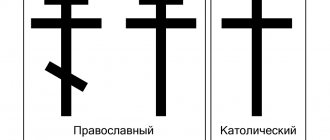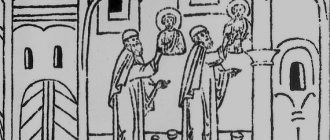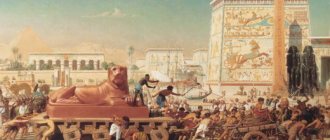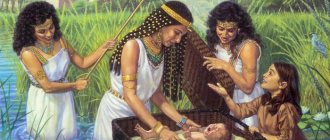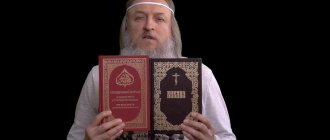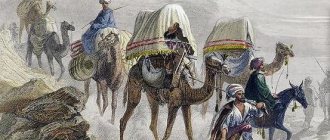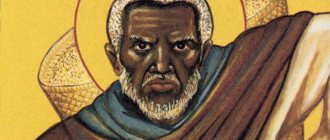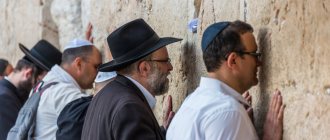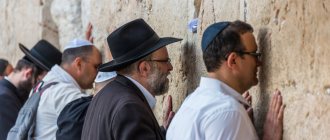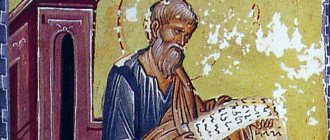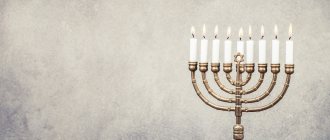Prophet Moses
Prophet Moses.
Monastery of St. Catherine, Sinai, Egypt After the death of Patriarch Joseph, the situation of the Jews changed dramatically. The new king, who did not know Joseph, began to fear that the Jews, having become a numerous and strong people, would go over to the enemy’s side in the event of war. He appointed commanders over them to wear them out with hard work. Pharaoh also ordered the killing of newborn Israelite boys. The very existence of the chosen people was under threat . However, God's Providence did not allow this plan to be carried out. God saved the future leader of the people, Moses, from death . This greatest Old Testament prophet came from the tribe of Levi. His parents were Amram and Jochebed (Exodus 6:20). The future prophet was younger than his brother Aaron and sister Mariam. The baby was born when Pharaoh's order to drown newborn Jewish boys in the Nile was in force. The mother hid her child for three months, but then was forced to hide him in a basket in the reeds on the river bank. Pharaoh's daughter saw him and took him into her house . Moses' sister, who was watching from afar, offered to bring a nurse. According to God's providence, it was arranged so that his own mother, who raised him in her home, became his nurse . When the boy grew up, his mother brought him to the pharaoh's daughter. Living in the king's palace as an adopted son, Moses was taught all the wisdom of Egypt, and was strong in words and deeds (Acts 7:22).
When he was forty years old , he went out to his brothers. Seeing that the Egyptian was beating the Jew, he, defending his brother, killed the Egyptian. Fearing persecution, Moses fled to the land of Midian and was received in the house of the local priest Raguel (aka Jethro), who married his daughter Zipporah to Moses.
Moses lived in the Midian country for forty years . Over these decades, he gained that inner maturity that made him capable of accomplishing a great feat - with the help of God, freeing the people from slavery . This event was perceived by Old Testament people as central in the history of the people. It is mentioned more than sixty times in the Holy Scriptures. In memory of this event, the main Old Testament holiday was established - Easter . The outcome has spiritual and educational significance. The Egyptian captivity is an Old Testament symbol of the slavish subordination of humanity to the devil until the redemptive feat of Jesus Christ. The Exodus from Egypt marks spiritual liberation through the New Testament Sacrament of Baptism .
epiphanies in the entire history of the chosen people . Moses tended his father-in-law's sheep in the desert. He reached Mount Horeb and saw that the thorn bush was engulfed in flames, but was not burned . Moses began to approach him. But God called to him from the midst of the bush: do not come here; take off your shoes from your feet, for the place on which you stand is holy ground. And he said: I am the God of your father, the God of Abraham, the God of Isaac and the God of Jacob (Exodus 3:5-6).
Burning bush. Monastery of St. Catherine, Sinai, Egypt
The outer side of the vision - a burning but not consumed thorn bush - depicted the plight of the Jews in Egypt . Fire, as a destroying force, indicated the severity of suffering. Just as the bush burned and was not consumed, so the Jewish people were not destroyed, but were only purified in the crucible of disasters. This is a prototype of the Incarnation. The Holy Church adopted the symbol of the Burning Bush of the Mother of God . The miracle lies in the fact that this thorn bush, in which the Lord appeared to Moses, has survived to this day. It is located in the fence of the Sinai monastery of St. Catherine the Great Martyr.
The Lord who appeared to Moses said that the cry of the sons of Israel suffering from the Egyptians had reached Him .
God sends Moses to carry out a great mission: bring My people, the children of Israel, out of Egypt (Exodus 3:10). Moses humbly speaks of his weakness. God responds to this indecision with clear words full of all-conquering power: I will be with you (Exodus 3:12). Moses, having accepted high obedience from the Lord, asks the name of the Sender. God said to Moses: I am who I am (Exodus 3:14). The word Jehovah in the Synodal Bible conveys the hidden name of God, inscribed in the Hebrew text with four consonants ( tetragram ): YHWH. The above passage shows that the prohibition to pronounce this secret name appeared much later than the time of the Exodus (perhaps after the Babylonian captivity).
While reading sacred texts aloud in the tabernacle, temple, and later in synagogues, another name of God was pronounced instead of the tetragram - Adonai . In Slavic and Russian texts the tetragram is rendered by the name Lord . In biblical language, Jehovah expresses the personal principle of absolute self-sufficient being, on which the existence of the entire created world depends.
The Lord strengthened Moses' spirit with two miraculous acts . The rod turned into a snake, and Moses' hand, which was covered with leprosy, was healed. The miracle with the rod testified that the Lord was giving Moses the authority of the leader of the people. The sudden defeat of the hand of Moses by leprosy and its healing meant that God had endowed His chosen one with the power of miracles to fulfill his mission.
Moses said he was tongue-tied. The Lord strengthened him: I will be with your mouth and teach you what to say (Exodus 4:12). Aaron as an assistant .
Coming to Pharaoh, Moses and Aaron, on behalf of the Lord, demanded that the people be released into the desert to celebrate the holiday. Pharaoh was a pagan. He declared that he did not know the Lord and that the people of Israel would not let them go. Pharaoh became bitter against the Jewish people. Jews did hard work at this time - they made bricks. Pharaoh ordered their work to be made more difficult. God again sends Moses and Aaron to declare His will to Pharaoh. At the same time, the Lord commanded to perform signs and wonders.
Aaron cast down his rod before Pharaoh and his servants, and it became a serpent. The wise men and sorcerers of the king and the magicians of Egypt did the same with their spells: they threw down their rods, and they became snakes, but Aaron’s rod swallowed up their rods .
The next day the Lord commanded Moses and Aaron to perform another miracle. When Pharaoh walked to the river, Aaron struck the water with his rod in front of the king's face and the water turned into blood . All the reservoirs in the country were filled with blood. Among the Egyptians, Nile was one of the gods of their pantheon. What happened with the water was supposed to enlighten them and show the power of the God of Israel. But this first of ten Egyptian plagues only further hardened Pharaoh’s heart.
The second execution took place seven days later. Aaron stretched out his hand over the waters of Egypt; and frogs came out and covered the earth . The disaster prompted Pharaoh to ask Moses to pray to the Lord to remove all the frogs. The Lord fulfilled the requests of His saint. Toads are extinct. As soon as the king felt relief, he again fell into bitterness.
the third execution followed . Aaron struck the ground with his rod, and midges appeared and began to bite people and livestock. In the Hebrew original these insects are called kinnim, in the Greek and Slavic texts - scnipi. According to the 1st century Jewish philosopher Philo of Alexandria and Origen, these were mosquitoes - a common scourge of Egypt during the flood period. But this time all the dust of the earth became midges throughout the whole land of Egypt (Exodus 8:17). The Magi were unable to repeat this miracle. They said to the king: This is the finger of God (Exodus 8:19). But he didn't listen to them. The Lord sends Moses to Pharaoh to tell him on behalf of the Lord to let the people go. If he does not comply, then flies will be sent throughout the country. This was the fourth plague . Her weapon was flies. They were called canine , apparently because they had a strong bite. Philo of Alexandria writes that they were distinguished by their fierceness and persistence. The fourth plague has two features. First, the Lord performs a miracle without the mediation of Moses and Aaron . Secondly, the land of Goshen, in which the Jews lived, was freed from disaster so that Pharaoh could clearly see the absolute power of God . The punishment worked. Pharaoh promised to release the Jews into the desert and make a sacrifice to the Lord God. He asked to pray for him and not to go far. Through the prayer of Moses, the Lord removed all the dog flies from Pharaoh and the people. Pharaoh did not let the Jews go into the desert.
followed - a pestilence that struck all Egyptian livestock. The Jewish cattle are no longer in trouble. God also carried out this execution directly, and not through Moses and Aaron. Pharaoh's tenacity remained the same.
The sixth plague was carried out by the Lord only through Moses (in the first three, Aaron was the mediator). Moses took a handful of ashes and threw them towards the sky. People and livestock were covered in boils . This time the Lord Himself hardened Pharaoh's heart. He did this, apparently, in order to further reveal His all-conquering power to the king and all the Egyptians. God says to Pharaoh: Tomorrow, at this very time, I will send a very strong hailstorm, the like of which has not been seen in Egypt since the day it was founded until now (Exodus 9:18). The sacred writer notes that those servants of Pharaoh who feared the words of the Lord hastily gathered their servants and flocks into houses. The hail was accompanied by thunder, which can be explained as the voice of God from heaven . Psalm 77 provides additional details of this execution: their grapes were beaten with hail and their sycamores with ice; their cattle were given over to hail, and their flocks to lightning (47-48). Blessed Theodoret explains: “The Lord brought hail and thunder , showing that He is the Lord of all the elements.” God carried out this execution through Moses. The land of Goshen was not damaged. This was the seventh plague . Pharaoh repented: this time I sinned; The Lord is righteous, but I and my people are guilty; Pray to the Lord: let the thunders of God and the hail cease, and I will let you go and hold you no longer (Exodus 9:27-28). But the repentance was short-lived. Soon the pharaoh again fell into a state of bitterness .
The eighth plague was very terrible. After Moses stretched out the rod over the land of Egypt, the Lord brought a wind from the east that lasted day and night. Locusts attacked all the land of Egypt and ate all the grass and all the greenery on the trees . Pharaoh repents again, but, apparently, as before, his repentance is superficial. The Lord hardens his heart.
The peculiarity of the ninth plague is that it was caused by the symbolic action of Moses stretching out his hands to heaven. thick darkness for three days . By punishing the Egyptians with darkness, God showed the insignificance of their idol Ra, the sun god. Pharaoh yielded again.
The tenth execution was the most terrible. The month of Abib has arrived. Before the exodus began, God commanded that Passover be celebrated. This holiday became the main one in the Old Testament sacred calendar.
Fresco of the church in Kurbinovo, Macedonia
The Lord told Moses and Aaron that each family on the tenth day of Abib (after the Babylonian captivity, this month became known as Nisan) took one lamb and kept it separately until the fourteenth day of this month, and then slaughtered it. When the lamb is slain, they shall take some of its blood and place it on both the doorposts and on the lintel of the doors of the houses where they will eat it .
At midnight on the 15th of Abib, the Lord struck down all the firstborn in the land of Egypt , as well as all the firstborn of livestock. The firstborn Jews were not harmed. As the doorposts and lintels of their houses were anointed with the blood of the sacrificial lamb, the angel who struck the firstborn of Egypt passed by. The holiday established in memory of this event was called Easter (Hebrew Pesach; from a verb meaning to jump over something, to pass by).
The blood of the lamb was a prototype of the atoning Blood of the Savior, the Blood of cleansing and reconciliation . Unleavened bread (unleavened bread), which Jews were supposed to eat on Easter days, also had a symbolic meaning: in Egypt, Jews were in danger of becoming infected with pagan wickedness. However, God brought the Jewish people out of the land of enslavement, made them a spiritually pure people, called to holiness: And you will be holy people to Me (Exodus 22:31). He must reject the previous leaven of moral corruption and begin a pure life . Unleavened bread, which is prepared quickly, symbolized the speed with which the Lord led His people out of the land of enslavement.
The Easter meal expressed the general unity of its participants with God and among themselves . The fact that the lamb was cooked whole, including the head, also had a symbolic meaning. The bone should not have been crushed .
Biblical miracle
According to the Bible, in the 13th century BC, the founder of the religion of Judaism, Moses, who managed to unite all the Israeli tribes into a single people, received a command from God to lead his fellow tribesmen out of Egypt. By that time, the Israelis had been under the rule of Pharaoh Ramesses II for decades, a talented and cruel commander who desperately sought to restore Egypt's former greatness by conquering Asia. To this end, he invaded the land of Goshen, located in the Nile Delta, where Israeli tribes had lived for several centuries, and on the captured territory he built the cities of Pithom and Raamses, which became a strategic springboard for the pharaoh in the decisive push to the east. From that time on, the long period of Israeli slavery and persecution by the Egyptian authorities against a large but scattered people began, colorfully described in the Old Testament. After numerous miracles performed by Moses, which angered the hard-hearted Pharaoh, and the “plagues of Egypt,” 45 thousand Israelis with livestock and household belongings left Egypt. Having learned about the flight of the conquered people, Ramesses II, together with his army, set off in pursuit of the Israelis and overtook them near the shore of the Red Sea. Having learned about the approach of his pursuers, Moses “cut” the waters with the help of a magic rod. Along the exposed bottom, the Israelis safely crossed to the opposite bank. When Pharaoh's chariots drove into the passage formed between the seething walls of water, Moses extended his hands - and in the blink of an eye the sea closed over the heads of the enemies.
Sinai Covenant and 10 Commandments
In the 3rd month after leaving Egypt, the Israelites approached Mount Sinai and camped opposite the mountain. Moses first ascended the mountain, and God warned him that he would appear before the people on the third day.
And then this day came. The phenomenon in Sinai was accompanied by terrible phenomena: clouds, smoke, lightning, thunder, flames, earthquakes, and the sound of a trumpet. This communication lasted 40 days, and God gave Moses two tablets - stone tablets on which the Law was written.
1. I am the Lord your God, who brought you out of the land of Egypt, out of the house of slavery; Let you have no other gods before Me.
2. Do not make for yourself an idol or any image of anything that is in heaven above, or that is on the earth below, or that is in the water below the earth; You shall not worship them or serve them, for I am the Lord your God. God is jealous, punishing the iniquity of the fathers on the children to the third and fourth generation of those who hate me, and showing mercy to a thousand generations of those who love me and keep my commandments.
3. Do not take the name of the Lord your God in vain, for the Lord will not leave without punishment the one who takes His name in vain.
4. Remember the Sabbath day, to keep it holy; six days thou shalt work, and do all thy work; but the seventh day is a Sabbath unto the Lord thy God: in it thou shalt not do any work, neither thou, nor thy son, nor thy daughter, nor thy manservant, nor thy maidservant, nor yours, nor your donkey, nor any of your livestock, nor the stranger who is in your gates; For in six days the Lord created heaven and earth, the sea and everything in them, and rested on the seventh day; Therefore the Lord blessed the Sabbath day and sanctified it.
5. Honor your father and your mother, (so that it may go well with you and) so that your days may be long in the land that the Lord your God is giving you.
6. Don't kill.
7. Do not commit adultery.
8. Don't steal.
9. Do not bear false witness against your neighbor.
10. Thou shalt not covet thy neighbor's house; Thou shalt not covet thy neighbor's wife, nor his field, nor his manservant, nor his maidservant, nor his ox, nor his donkey, nor (any of his livestock), nor anything that is thy neighbor's.
The law that was given to ancient Israel by God had several purposes. First, he asserted public order and justice. Secondly, he singled out the Jewish people as a special religious community professing monotheism. Thirdly, he had to make an internal change in a person, morally improve a person, bring a person closer to God through instilling in a person the love of God. Finally, the law of the Old Testament prepared humanity for the adoption of the Christian faith in the future.
The Decalogue (ten commandments) formed the basis of the moral code of all cultural humanity.
In addition to the Ten Commandments, God dictated laws to Moses that outlined how the people of Israel should live. So the Sons of Israel became a people - Jews .
The meaning of the Battle of Kadesh, the peace treaty with the Hittites
The Battle of Kadesh went down in history as the last battle of the Bronze Age. The Hittites had already begun to use iron, which showed its effectiveness in battle. Its production was a state secret. The Hittites had powerful chariots with three warriors on board, which increased their fighting power. The Egyptians' chariots were lighter and more maneuverable; they carried two people. However, the Egyptian carts had a huge advantage: warriors with large bows sat on them. Scientists believe that the presence of powerful detachments of spearmen in the Egyptian army, which the Hittites did not have, saved Ramses. Also, the use of bows and arrows on chariots caused panic among the enemy; many of their carts simply did not arrive, while the rest turned back in horror. But there was still infantry left. Having erected a wall similar to a phalanx, the Egyptians were able to cope with superior enemy forces here too.
Having suffered huge losses, the pharaoh's army still remained on the battlefield, and the Hittites retreated, despite their superiority. However, the most important thing was not achieved: the city of Kadesh in Syria remained with the enemy, Ramses was unable to take it.
After an unsuccessful assault on the city, the Hittite emperor Muwattali sued for peace. Both sides considered the Battle of Kadesh a victory. The interest of historians in it is due to the fact that it was the first battle that was mentioned on both sides. Based on these data, one could judge the reliability of written sources.
Incredible hypotheses
Thus, in particular, the Israeli geologist Yehudi Menachem stated in 2005 that the exposure of the bottom of the Red Sea during Moses' crossing was associated with a strong earthquake that occurred on the Arabian Peninsula in the second half of the 13th century BC. The earthquake caused a rapid ebb of water into the Gulf of Aden, and then turned into a destructive tsunami, which most likely destroyed the pharaoh's army. American orientalist David Warren, after analyzing Chinese chronicles of that period, suggested that the legendary waste of water was caused by the gravitational forces of a large comet then seen in the sky. He is echoed by the English researcher Charles Masterson, who in 2009 stated that the biblical miracle was caused by... the planet Nibi-ru, which approached the Earth at a minimum distance that day. According to Masterson, the negative impact of the space guest also explains the famous “Egyptian executions” that befell the subjects of Ramesses II. No less interesting is the version of the British UFO Society, according to whose members, the exposure of the bottom was caused by the influence of... an alien ship. This hypothesis, according to ufologists, is confirmed in a number of ancient Egyptian sources; it is also reflected in later Roman chronicles, which mention a fiery chariot that overshadowed from the sky the path of ships heading to the ports of the Red Sea. The Bible also indirectly mentions this, indicating that the path for Moses on his dangerous journey was illuminated by a bright cloud, supposedly sent by the god Yahweh. Today, many question the reality of the events described in biblical sources. And this is not surprising, because it is difficult for a modern person to imagine how limitless and inexplicable the influence of higher powers can be, the existence of which was well known to people of previous historical eras.
Magazine: Secrets of the 20th century No. 28, July 2012 Category: Myth and reality Author: Sergey Kozhushko
Tags: Ancient Egypt, Secrets of the 20th century, water, sea, bible, hypothesis, Red Sea, Jews, exodus, Moses
- Back
- Forward
Progress of the battle
The battle took place in Syria, which was controlled by the Hittites. Ramses, believing the Bedouin nomads who had deceived him, divided his forces and went forward with a smaller force, defeating a small force near Aleppo. Meanwhile, the Hittites with a huge army attacked the main forces of the Egyptians that Ramses had left and defeated them. The chronicles mention that almost the entire army of Egypt was destroyed, even the children of the pharaoh died. After this, the Hittites surrounded Ramses.
Literary monuments tell that Ramses himself fought alone against 30 Hittite and 40 Syrian chariots, was wounded, but turned to the god Ra. Ra heard the pharaoh and punished the enemies with a ray emanating from Ramses' head. The enemies fled in horror. The legend is not far from the truth: the pharaoh himself personally participated in the battle, armed with a bow, and exterminated people on war chariots from a distance. The Hittites could not get close, as they were destroyed on the outskirts.
Construction of the capital
The reign of Ramses the Great is not only about major military successes in the international arena, but also about internal development. One of the outstanding deeds of the pharaoh was the construction of a new city - Per-Ramses. Historians believed that the place was not chosen by chance: this place was the capital of the ancient Hyksos, who had enslaved the ancestors of the Egyptians. In this way, the pharaoh showed not just his independence, but his numerous victories. Some argue that the construction of the city began with Seti I, but was completed by Ramses.
The city had huge rectangular buildings, and the foot of a statue of the pharaoh himself was found. The city had glass workshops, and the existence of an archive of Ramses the Great is also confirmed.
Battle of Kadesh (1312 BC)
Ramses the Great fought with the Hittites for a long time, but the outstanding battle of Kadesh in 1312 BC went down in history. e. – it ended in a draw, but after it Egypt signed a peace treaty that was beneficial for itself.
The battle near the city of Kadesh was one of the grandiose battles in which 5-6 thousand war chariots took part. Even Darius, the ruler of the vast Persian empire, could not afford so much much later.
Historical sources, such as the "Poem of Pentaur", tell descendants about the personal valor of the pharaoh himself. He acted at the head of an advance detachment of 2 thousand people and 400 chariots - the “army of Ra”. Nearby he was covered by the “army of Ptah” in the amount of 4 thousand people and 800 chariots, and in reserve there was the “army of Thoth” - 8 thousand people and 2 thousand chariots. Arab horse mercenaries acted on Ramses's side.
The forces were unequal: the garrison of Kadesh alone numbered about 28 thousand people. The Hittites also had a huge cavalry - 5 thousand people.
New ruler
All pharaohs of Egypt were considered messengers of higher powers. All rulers were described and revered in approximately the same way. Some stylistic features when describing a particular pharaoh were often necessary only in order not to copy the previous ones exactly. The new pharaoh, later nicknamed the Great, was very young. However, from his first days it became clear that this ruler would achieve a lot. What great did Ramses do, whose 13th son, Merneptah, succeeded him after his death?
Having ascended the throne, the new ruler immediately ordered the names of his predecessors to be obscured on all statues and monuments. He made it clear that for the Egyptian people the ruler of the 19th dynasty should be the only one. In addition, he declared himself the chosen one of Amun - the invincible hero, the divine benefactor of Egypt, who would later merge with the image of the god Ra.
Historians' mistake
At the same time, American scientists Carl Druce and Weiqing Han, without questioning the reality of the events that occurred 33 centuries ago in the Middle East, believe that even a very strong east wind was not able to drain such a vast area of deep-sea waters. Moreover, they made the bold assumption that numerous Bible scholars and Israeli historians were mistaken in mistaking the Old Testament Red Sea for the Red Sea. Translated from Church Slavonic, as well as from English, the Red Sea, or Red Sea, has another name - the Sea of Reeds. The Hebrew name for the sea that the Israelites crossed is also translated - Yam-Suf. However, reeds never grew in the Red Sea area. Based on this, American scientists invited the scientific community to discuss the hypothesis that Moses made his famous journey not across the sea, but through a lake, which in Old Testament times was located near the ancient city of Tanis in the eastern part of the Nile Delta. Nowadays this lake is called Menzala, and its shores abound with thickets of reeds. A thorough analysis of ancient maps and archaeological data, as well as computer modeling, allowed researchers to claim that such a miracle could have happened to the Israeli people on the shallow and overgrown Lake Menzala, the waters of which could well have been dispersed by a strong and prolonged wind. The research results were published, causing a mixed reaction from readers and a whole series of new, sometimes the most fantastic options for explaining the biblical miracle.
